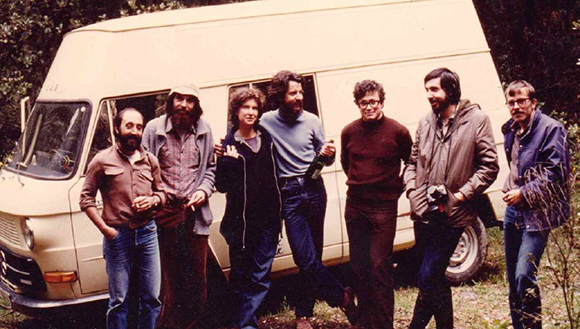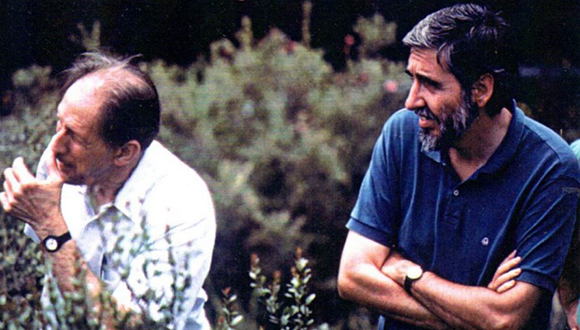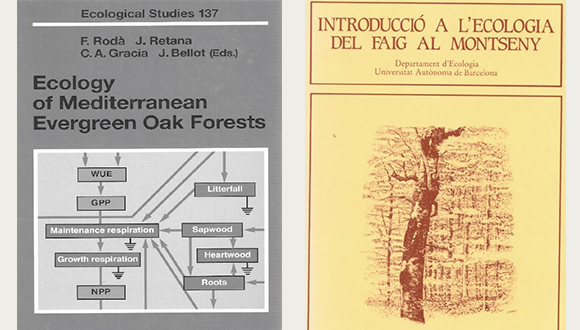Origins of terrestrial ecology in Catalonia
Jaume Terradas explains in this post how the discipline began in our country, and the capital role that some people played on it, such as Ramon Margalef and a group of young Catalan ecologists.

We celebrate now 50 years from the creation (1967) of the first chair of Ecology in Spain, which was occupied by Ramón Margalef. For this reason, the ecologists at the University of Barcelona have organized a series of seminars. The first was made on May 19th about the role played by Margalef in the beginnings of terrestrial ecology, a session with Antoni Escarré, Carlos Gracia, Ferran Rodà and myself as speakers. I was the second full professor of ecology in Catalonia (1974) and I read the first PhD thesis on terrestrial ecology (1973), although it was done in a Department of Botany, on climate and water economy in plants of the Monegros. As an adviser to Omega editions, I had some role in the editorial process of the book Ecología of Margalef (1974), and I had a frequent relationship with him for many reasons (I even tried to start a thesis with him in 1965, when I was in the last year of my career, but at that time he was director of the Institute of Fisheries Research and he had not time available).
My aim was to create a research team on terrestrial ecology at the UAB. However, it was obvious that it would be difficult to assemble a group over a critical mass. I spoke with Antoni Escarré, who also came from Botany and was then at Margalef’s department, and I proposed him to do jointly some studies in Montseny (where the UAB already did environmental education activities and others on behalf of the Natural Parks Service of The Diputació de Barcelona), based on the ecosystem-basin concept developed by Frederick Bormann and Gene Likens at Yale. We spoke later with Margalef, who had just spent a semester at Yale and knew both very well.
He liked the idea, at the end of 1976, he wrote a very ambitious first proposal for the ICONA (the National Institute for the Conservation of Nature) for the use of the Vilar de la Castanya house and the associated forests. I prepared two documents to determine some possible immediate activities. In 1978, I co-directed with Margalef a project of the Societat Catalana de Biologia on bioecology of the beech, granted by the Diputació and, with Escarré and the Yale partners, whom we visited in Hubbard Brook, we prepared a project to present to the Joint Committee Spanish-North-American, with Margalef and Bormann as principal researchers. The project was accepted and officially launched in March 1979.

Margalef accepted the heavy administrative burden of the project to help us get started. He was not involved in data collection, he already had enough work in his own field, but he helped us in many ways. Escarré won a chair in Alicante, and the work of Montseny was undertaken by the small groups of the UAB and the UB: It was mainly Ferran Rodà who started to implement the watershed and biogeochemical cycles equipment, while Carlos Gracia and Robert Savé did studies of oak and beech ecophysiology, Claret Verdú worked on the decomposition of litter and Lluís Ferrés on nutrient cycles.
Two years later, Bormann, sick, had to resign and Rodà persuaded Georges Hornberger, University of Virginia and disciple of Bormann, to relieve him. Margalef also resigned and I became the principal researcher on the Spanish side. Escarré set up, with the advice of Robert Pierce, director of Hubbard Brook station, a basin system in the Prades mountain range where people from all three universities worked. The project with the Americans ended in 1983, the year in which Rodà and Gracia PhD theses were read. In 1984 I coordinated a book on beech ecology, with Escarré I went to Coweeta station where Hornberger worked, with C. Gracia we presented both with C. Gracia a first synthesis of results in a congress in Uppsala and the three with Rodà we published a summary article in Investigación y Ciencia (the Spanish version of Scientific American).
Until now, hundreds of research papers have been published from all three universities, mostly on holm oak forests. In 1987 CREAF was founded, I became its director and Margalef accepted to be in the Board and in the Scientific Council of the new center as a representative of the Institut d'Estudis Catalans. In 1990, with the CEFE-CNRS of Montpellier, we set up a conference on the ecology of the holm oak that led to a book edited by François Romane and myself and in 1999 Rodà, Retana, Bellot and Gracia co-edited a volume on the same topic published by Springer Verlag, entirely with results from the studies at Montseny and Prades.

Since 1976, 40 years have passed. Work continues at the Montseny and Prades. Although most subjects of study have changed, some observations have series of 37 years, something certainly unusual in Mediterranean ecosystems. The holm oak forest is one of the forest ecosystems best known, although it is still much that we ignore. But those first two projects, especially the one with Yale and Virginia, established the bases of terrestrial ecology in Catalonia.
In those distant origins, Margalef played a crucial role. They financed us due to his prestige, we obtained the Yale's cooperation for the same reason and he invested many hours (and delayed the presentation of limnology projects that more directly concerned him) to help us get ahead. It is for these reasons that, in this fiftieth anniversary of the Department of Ecology that he created, we remember him with gratitude: the terrestrial ecology of three universities developed as a legacy not only of Margalef's ideas but also of his generous and totally selfless effort (he never signed a single work from these projects). Thirteen years after his death, all who knew him still miss him and we have a duty to talk about his ideas to the young ecologists.
UPDATE
In 1985, the Catalan Institution of Natural History (ICHN) published this article that explained the state of the Catalan regions at that time.







